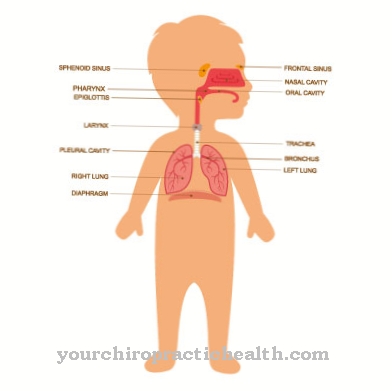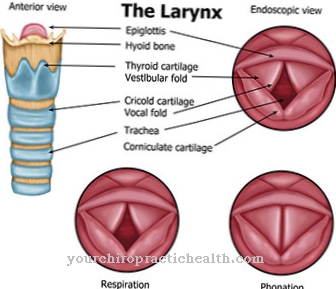The Couperose is a genetic weakness of the connective tissue that develops from the age of 30.Year of life based on visible vasodilatation (telangiectasia) in the face. In particular, people of the Celtic type (red-blonde hair, light skin) or people with easily irritable and sensitive skin are affected by couperose, which is not a classic disease, but rather a cosmetic problem. Couperose is an early form of rosacea (rosacea) or Copper fin.
What is couperose?

© Siniehina - stock.adobe.com
Couperose is an enlargement of the blood vessels (telangiectasias) in the face, which usually manifests itself from the age of 30 and which is based on a genetically determined weakness of the connective tissue.
In the early stages of couperose, temporary reddening of the cheeks and nose can be noticed. In the further course of blood congestion, permanent vascular enlargements and new formations of vessels develop, which are characterized by reduced elasticity and increased permeability.
This causes the symptoms characteristic of couperose, such as a visible vascular network on the face that shimmers through the skin, as well as pronounced reddening due to the leakage of blood into the surrounding tissue structures. In addition, in couperosis, a differentiation is made according to whether arterial vessels or venous vessels (venectasia) are affected, although mixed forms can also be observed.
causes
The exact causes of couperose have not yet been fully clarified. It is assumed that couperose can be traced back to a genetically determined weakness of the connective tissue, which with increasing age leads to blood congestion in the finest veins (capillaries) of the skin, especially the face.
The fact that light-skinned people with red-blonde hair (Celtic type) and people with sensitive skin are particularly affected by couperose also speaks for a genetic predisposition (disposition). As a result of excessive blood flow, the capillaries are permanently exposed to increased pressure, which leads to an expansion or expansion of the vessels and increased permeability of the vessel walls.
As a result of this process, a reddening occurs, which can become permanent in the further course. Excessive sunbathing, strong temperature fluctuations as well as excessive nicotine and alcohol consumption are external environmental factors that favor the manifestation of couperose.
You can find your medication here
➔ Medicines against redness and eczemaSymptoms, ailments & signs
Couperose causes those affected to suffer from a number of different skin complaints. These can have a very negative effect on the aesthetics of the person affected and thereby also significantly reduce the patient's quality of life. This often leads to depression and other psychological upsets, as those affected do not feel well and beautiful.
Children can also be teased or bullied because of their skin discomfort. Those affected suffer from redness on the skin, which occurs mainly on the face. A significant expansion of the vessels is also visible, so that bleeding can also occur on the skin. In general, there is then a weakness of the connective tissue, which has a negative effect on the health of the person concerned.
In many cases, couperose does not receive early treatment because the symptoms are not particularly characteristic and do not directly indicate the disease. If the skin bleeding is not treated, the couperose can also lead to inflammation under the skin, which is usually associated with pain. In most cases, the patient's life expectancy is not negatively affected by couperose.
diagnosis
Couperose can be diagnosed based on the characteristic skin changes on the face. However, diseases that lead to a complexion similar to rosacea, actinic changes in the skin or erythrosis should be excluded from the differential diagnosis.
In particular, it is difficult to differentiate from rosacea in many cases, as it is so aetiologically and symptomatically similar to couperose in its early stages that some experts assume the same disease.
Couperose is not considered a disease in the classic sense, but rather a cosmetic problem, especially since telangiectasias are particularly persistent. However, these can be eliminated or reduced with modern methods.
Complications
A number of complications can arise in the course of couperose. The pathological vascular changes initially cause skin reddening, which occurs in particular on the cheeks, on the forehead and on the nose and is associated with severe itching. This can lead to skin bleeding; as a result, inflammatory abscesses develop on the affected areas.
The vasodilation of the facial arteries also leads to the rapid formation of wrinkles and the risk of skin diseases is increased. Despite these complications, couperose is mainly a cosmetic problem, which rarely leads to major discomfort. When treating couperose, complications can arise if the skin care products used cause an allergy or further irritate the reddened skin that has already developed.
With the IPL2 light technology, in which the affected skin areas are closed with the help of a light pulse, a life-threatening thrombus can rarely occur. Surgical procedures are associated with similar risks, with serious complications being rare. Couperose can also run completely without complications. Problems usually arise from secondary diseases and symptoms accompanying the vascular changes and can almost always be avoided by seeing a doctor early.
When should you go to the doctor?
Couperose is a genetically determined vasodilatation in the facial area. From a medical point of view, couperose is not considered a disease, but merely a cosmetic problem. Since couperose can develop into a very disfiguring rosacea, which is also classified as a skin disease, the disorder should be treated.
Reddening of the skin on the cheeks and nose is typical of the onset of couperose, which is accompanied by clearly visible facial veins as well as skin bleeding and, very often, a weak connective tissue. Mostly people are affected, mostly women, aged 30 and over. A doctor should be consulted at the latest when vascular dilatations appear. The family doctor can act as the first point of contact, but the treatment should be carried out by a dermatologist who specializes in the treatment of couperose and rosacea.
Other doctors usually neither have sufficient specialist knowledge nor special equipment for treating couperose. Since very good results can be achieved with laser treatments, the attending physician should have this technique. This also applies if other forms of treatment initially seem appropriate. Qualified doctors and specialist clinics can be researched on the Internet or requested from the medical associations.
Couperose treatments offered by beauticians should if necessary be used in addition and after consultation with the treating dermatologist.
Doctors & therapists in your area
Treatment & Therapy
For couperose, low-irritation skin care products without perfume or preservatives are recommended. For a soothing, skin-stabilizing, anti-inflammatory and antimicrobial effect, active ingredients such as vitamin K1, D-panthenol, Boswellia sacra (frankincense), chamomile, aloe vera, echinacea (coneflower), linseed oil or evening primrose oil are recommended, which in combination with liposome concentrates increase skin penetration and Can have an impact.
Make-up or powder with green pigments applied locally to the affected skin area neutralizes the reddish color of the skin. There are also cosmetic procedures to remove telangiectasias. For example, the affected vessels in the face can be obliterated as part of laser therapy.
With the help of so-called IPL2 light technology (Intense Pulsed Light), for example, a controlled light pulse is emitted onto the affected skin area, which is absorbed by the hemoglobin in the blood and then converted into heat. This induces heating in the blood vessels, which leads to coagulation (clotting).
As a result, the treated vessels stick together, die and are metabolized or removed by the human organism via the lymphatic system. However, visible vasodilatation can occur again even after this treatment, since couperose is a chronic disease for which no causal therapy has yet been found.
Outlook & forecast
Couperose is a permanent change in normal, healthy skin and will last for a lifetime. However, the development of the disease can be favored by the right skin care so that those affected do not have to suffer from the visual effects on the face and skin.
After the medical examination and diagnosis, it is often enough to contact an experienced beautician who can design a care program tailored to the couperose with special products for the person affected. If this is strictly adhered to and if you do not experiment with other products and methods on your own, the severity of couperose will level off over time to a level that is tolerable for the patient. Usually there are no more complaints once the skin care has settled down. This is time-consuming and often not very cheap, but over time a visually more beautiful complexion arises than without the care.
Couperose can of course improve or worsen in phases due to influences such as environmental pollution, unhealthy diet, stress, insufficient skin care or hormonal causes. However, these are usually only changes of a few days to weeks. Then the skin returns to its normal appearance while maintaining the previous skin care and the couperose returns to its usual state.
You can find your medication here
➔ Medicines against redness and eczemaprevention
Since the exact causes of couperose have not yet been fully clarified, it cannot be prevented. It is known, however, that extreme temperature fluctuations (e.g. sauna, unprotected areas of the face in winter), increased solar radiation, alcohol and nicotine consumption as well as caffeine and spicy food strain the sensitive connective tissue in the nose and cheeks and can promote and worsen couperose.
Aftercare
In most cases, those affected have very few follow-up measures available for couperose. The disease must first and foremost be recognized early by a doctor so that further complications and complaints can be avoided. It cannot heal on its own, so that those affected should ideally see a doctor at the first symptoms and signs of this disease.
If you want to have children, genetic counseling and examination can also be useful in order to prevent the recurrence of couperose. The disease itself can be treated by taking various medications. The affected person should ensure that they are taken regularly and that the dosage is correct in order to permanently alleviate the symptoms.
If anything is unclear or if you have any questions, a doctor should be consulted first. Regular examinations of the entire body are also necessary in order to also check the internal organs. Furthermore, the support and care of family and friends has a very positive effect on the further course of the disease. In many cases, contact with other sufferers of couperose can also be useful, as this leads to an exchange of valuable information.
You can do that yourself
Since couperose usually occurs as an early form of rosacea, a dermatologist should definitely be consulted. Affected people can also contribute to keeping their suffering under control.
Acute couperose flare-ups are usually triggered by emotional excitement and stress, profuse sweating, for example during exercise or in the sauna, and the consumption of alcohol and certain foods. Not all of these triggers can be consistently avoided. However, those affected should avoid regular visits to saunas and steam baths. Extreme exertion should be avoided when exercising.
Water sports are usually more tolerable than sports that involve heavy sweating. Those affected should also observe whether and to which foods they are sensitive. Hot spices are generally considered critical, but the couperose attacks can also be triggered by other foods.
When caring for the skin, only mild, pH-neutral cleaning agents and creams that are low in irritants should be used. Washing with water that is too hot or alternating hot-cold baths, which strongly stimulate blood circulation, should also be avoided.
The couperose can be visually concealed with special camouflage make-up from the pharmacy or cosmetic retailer. People who have no experience in using make-up can have a beautician explain the correct use of these products to them.

.jpg)
.jpg)





















.jpg)



